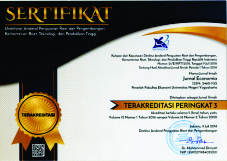Exploratory Study of Cigarette Consumption Behavior: Perspective of Motive, Brand and Cigarette Advertisement
Downloads
Abstract: Exploratory Study of Cigarette Consumption Behavior: Perspective of Motive, Brand and Cigarette Advertisement. This study aims to explore the primary motives of cigarette consumption behavior, opinions related to the cigarette brand and advertisement as well as to identify the expense spent to consume cigarette. This study applied qualitative research. The sources of information were the students of Universitas Negeri Yogyakarta who were smokers. The technique of data analysis used in this study was qualitative descriptive. This study found that the reason underlined the respondents smoking, internally, were attempts, while the external factors that drove the respondent smoking were friends and relatives invitation, seeing the parents, joining the smoking environment or neighborhood, and looking cool according to the students. Brand was one of the considerations in choosing the cigarette related to the advertisement. Advertisement dominated by the cigarette producer brought more encouragement to the respondents than public service advertisements about the danger of smoking. The selling price of cigarette was also the main consideration by the respondent to smoke. The monthly expense spent for smoking was considerably high.
Keywords: motive, cigarette consumptions, brand, advertisement
Abstrak: Studi Eksplorasi Perilaku Konsumsi Rokok: Perspektif Motif, Merek, dan Iklan Rokok. Penelitian ini bertujuan mengeksplorasi motif dasar perilaku konsumsi rokok, pendapat terkait merek dan iklan rokok, serta mengidentifikasi biaya yang dikeluarkan untuk konsumsi rokok. Penelitian ini bersifat kualitatif. Informan yang menjadi sumber informasi dalam penelitian mahasiswa di UNY yang merokok. Teknik analisis data dalam penelitian menggunakan deskriptif kualitatif. Penelitian ini menemukan bahwa secara internal alasan yang mendasari responden merokok adalah coba-coba dan iseng sedangkan faktor eksternal yang mendorong responden merokok adalah diajak teman, kerabat atau melihat orangtua, ikutan karena lingkungan rokok dan terlihat lebih menarik atau istilahnya terlihat keren menurut versi mahasiswa. Merek menjadi salah satu pertimbangan pemilihan rokok yang terkait dengan iklan. Iklan yang didominasi dari produsen rokok membawa dorongan yang lebih kuat bagi responden untuk merokok dibandingkan iklan layanan masyarakat tentang bahaya rokok. Harga rokok menjadi pertimbangan utama bagi responden untuk mengkonsumsi rokok. Biaya yang dikeluarkan per bulan untuk konsumsi rokok responden tergolong cukup besar.
Kata-kata kunci: Motif, Konsumsi Rokok, Merek, Iklan
Downloads
Aldiabat, K & Clinton. (2012). Contextualizing Smoking Behaviour over Time: A Smoking Journey from Pleasuring to Suffering. Turkish Online Journal of Qualitative Inquiry, 3(1), 1-19.
Aritonang, MER. (1997). Fenomena Wanita Merokok. Skripsi. Tidak diterbitkan. Yogyakarta: Fakultas Psikologi UGM.
Babatunde, O.A. (2012). Smoking Prevalence, Willingness to Quit and Factors Influencing Smoking Cessation among University Students in A Western Nigerian State. Asian Social Science. 8(7), 149-156.
Byeon, H. (2015). Association among smoking, depression, and anxiety: findings froma representative sample of Korean adolescents. PeerJ, DOI: https://doi.org/10.7717/peerj.1288.
Cahyani, B. (1995). Hubungan antara Persepsi terhadap Merokok dan Kepercayaan Diri dengan Perilaku Merokok pada Siswa STM Muhammadiyah Pakem Sleman Yogyakarta. Skripsi. Tidak diterbitkan. Yogyakarta: Fakultas Psikologi UGM
Frí¶jd S, Ala-Soini P, Marttunen M, Kaltiala-Heino R (2013) Depression Predicts Smoking among Adolescent Girls but Not among Boys. Journal of Child Adolescent Behavior. 1(3), 1-6.
Gatchel, R.J. (1989). An Introduction to Health Psychology. New York: Mc Graw-Hill Book Company
Haddad, L.G. & Petro-Nustas, W. (2006). Predictors of Intention to Quit Smoking Among Jordanian University Students. Canadian Journal of Public Health. 97(1), 9-13.
Hertel, A.W. & Mermelstein, R.J. (2016). Smoker Identity Development among Adoslescents Who Smoke. Psychology of Addictive Behaviors. 30(4), 75-83.
Levitt, C, Shaw, E, Wong, S & Kaczorowski, J. (2007). Systematic Review of the Literature on Postpartum Care: Effectiveness of Interventions for Smoking Relapse Prevention, Cessation, and Reduction in Postpartum Women. Nursing Research. 34(4), 1-7.
Levy, M.R. (1984). Life and health. New York:Random House
í–ncel, S.Y, í–mer, L.G, & Fazil, A.A. (2011). Risk factors for smoking behavior among university students. Turkish Journal of Medical Sciences. 41(6), 1071-1080.
Orcullo, D.JC. & San, T.H. (2016). Understanding Cognitive Dissonance in Smoking Behaviour: A Qualitative Study. International Journal of Social Science and Humanity. 6(6), 481-484.
Park, S. & Dan, R. (2007). Associations between Smoking and Depression in Adolescence:An Integrative Review. Journal of Korean Academy of Nursing. 37(2), 227-241.
Peraturan Rektor Universitas Negeri Yogyakarta. Nomor 3 Tahun 2013 Tentang Area Tanpa Rokok.
Prabandari, Y. S., (1994). Pendidikan kesehatan melalui seminar dan diskusi sebagai alternatif penanggulangan perilaku merokok pada remaja pelajar SLTA di Kodya Yogyakarta. Thesis (tidak diterbitkan). Yogyakarta: Program Pasca Sarjana Universitas Gadjah Mada.
Qidwai, W. (2004). Barriers to Smoking Cessation: Results of A Survey Among Family Practice Patients. Middle East Journal of Family Medicine. 5(5).
Suhariyono, A. (1993). Intensitas Merokok dan Kecenderungan Memilih Tipe Strategi Menghadapi Masalah pada siswa SMTA di Yogyakarta. Skripsi. Tidak diterbitkan. Yogyakarta: Fakultas Psikologi UGM.
Taylor, S.E. (1995). Health Psychology, third edition. New York: Mc Graw Hill, Inc
Tsoh, J., Lam, J. & Delucchi, K. (2003). Smoking and Depression in Chinese Americans. The American Journal of The Medical Sciences. 326(4), 87-91.
De Wilde, K.S., et.al. (2013). Smoking Patterns, Depression, and Sociodemographic Variables Among Flemish Women During Pregnancy and the Postpartum Period. Nursing Research, 62(6), 394–404.
Windle, M. & Windle, R.C. (2001). Depressive Symptoms and Cigarette Smoking Among Middle Adolescents: Prospective Associations and Interpersonal and Interpersonal Influences. Journal of Consulting and Clinical Psychology. 69(2), 15-26.















